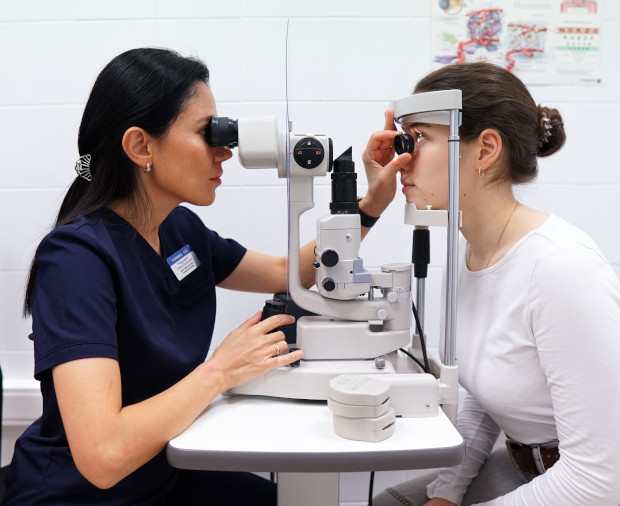Removal of the uterus (hysterectomy)

specialists

equipment

treatment

Removal of the uterus is prescribed when other treatment methods are ineffective. Indications for the operation include:
- Fibroids. A benign tumor that causes pain, severe bleeding, pressure on neighboring organs
- Oncological diseases. Removal of the uterus stops the development of endometrial, cervical, and ovarian cancer
- Endometriosis. Cells that are normally found inside the uterus begin to grow outside of it. Provoke pain, disrupt the functioning of the pelvic organs
- Adenomyosis. If the endometrium grows into the muscular wall of the uterus, the woman experiences pain and heavy menstruation
- Uterine prolapse. Organ prolapse is accompanied by discomfort, difficulty urinating, and pain. Removal of the uterus is the most effective way to eliminate unpleasant symptoms
Uncontrolled uterine bleeding is a serious threat to life. Removing the uterus helps stop blood loss, prevent anemia and other dangerous conditions.

Removal of the uterus is not performed if the following restrictions exist:
- Active infections, inflammation in the pelvic area. They must first be cured to avoid complications during hysterectomy
- Diseases of the heart and lungs. Surgery can lead to complications
- Hemophilia. The risk of bleeding during surgery increases significantly
- Pregnancy. Intervention is carried out only in exceptional situations when a woman’s life is at risk
- Allergic reactions to drugs used for general anesthesia and epidural anesthesia. The operation carries significant risks
In addition, the operation is carried out in the presence of purulent pathologies in the abdominal cavity.
Types of hysterectomy and the course of the operation
Total hysterectomy
During the operation, the doctor completely removes the uterus along with the cervix. Total hysterectomy is indicated for large fibroids, cancer, and severe forms of endometriosis.
Removal of the uterus is carried out using the abdominal method through an incision in the abdomen or laparoscopically through small punctures. At the end of the operation, the surgeon applies stitches.
With the abdominal technique, recovery takes about 4–6 weeks. The laparoscopic method allows you to reduce the rehabilitation period to 2–3 weeks. At first, slight discomfort is possible, but gradually the woman returns to her normal life.
Subtotal hysterectomy
Only the body of the uterus is removed. If the cervix is healthy and there is no risk of cancer, it is left.
Removal of the uterus is performed laparoscopically or through the vagina. Rehabilitation lasts 2–4 weeks. After surgery, it is important to follow your doctor's recommendations to avoid cervical inflammation.
Radical hysterectomy
Removal of the uterus, cervix, upper part of the vagina and tissue around the organ. The operation is usually performed for cervical cancer. The doctor removes the affected tissue and nearby lymph nodes through an incision in the abdomen.
Recovery takes up to 6–8 weeks. This is a complex intervention, so additional treatment, such as chemotherapy, is possible during the rehabilitation period.
Hysterectomy with removal of appendages
The ovaries and fallopian tubes are removed along with the uterus. Surgery is prescribed for cysts, tumors, and severe forms of endometriosis.
Removal of the uterus is performed laparoscopically through small punctures. The organ is removed along with its appendages.
After laparoscopy, recovery takes 2–4 weeks. Removing your ovaries can cause menopausal symptoms such as hot flashes and mood swings.
General information about the procedure
Answers to popular questions
Doctors at the K+31 clinic answered frequently asked questions about hysterectomy.
Do complications arise after the intervention?
Hysterectomy, like any operation, can cause complications. These include bleeding, infection and blood clots. In rare cases, damage to nearby organs, such as the bladder, may occur. If after surgery you experience severe pain, fever and unusual discharge, you should consult a doctor.
How does surgery affect fertility?
After removal of the uterus, a woman can no longer become pregnant. If the ovaries are preserved, the hormonal levels remain stable, and menopause occurs naturally. If the ovaries are removed, hormone therapy is required. It reduces the severity of menopausal symptoms.
Do I need to visit a gynecologist after surgery?
Yes, routine examinations remain an important part of health monitoring. Even if the uterus is removed, it is important to monitor the condition of the ovaries, cervix and other pelvic organs.
Is it possible to avoid hysterectomy?
Sometimes hysterectomy is replaced by other treatment methods. For example, your doctor may suggest medications or uterine artery embolization (cutting off blood flow to the fibroid). The choice depends on the woman’s health and her plans for the future.
Will there be pain after surgery?
Pain after surgery is a common occurrence in the first days of rehabilitation. To alleviate the condition, you can take a pain reliever.
Does surgery affect a woman's appearance?
Removing the uterus does not change the appearance. If the ovaries are preserved, hormones continue to be produced. The condition of the skin, hair and nails remains the same. When the ovaries are removed, changes may occur due to decreased hormone levels. Then the doctor helps to correct them.

This award is given to clinics with the highest ratings according to user ratings, a large number of requests from this site, and in the absence of critical violations.

This award is given to clinics with the highest ratings according to user ratings. It means that the place is known, loved, and definitely worth visiting.

The ProDoctors portal collected 500 thousand reviews, compiled a rating of doctors based on them and awarded the best. We are proud that our doctors are among those awarded.
Make an appointment at a convenient time on the nearest date
Price
Other services













































What is a hysterectomy?
Hysterectomy is an operation to remove the uterus, performed when conservative treatment is ineffective. The uterus is the organ of the female reproductive system in which the fetus develops during pregnancy. It is located in the pelvis and is connected to the ovaries, fallopian tubes and vagina.
There are 2 types of hysterectomy:
Sometimes the ovaries or fallopian tubes are removed along with the uterus if this is required for medical reasons.
The intervention is carried out using three methods:
When choosing a method, the doctor takes into account the patient’s health status, diagnosis and characteristics of the body. Removing the uterus is an important and responsible step, which eliminates the possibility of becoming pregnant, but allows you to avoid health problems in the future.